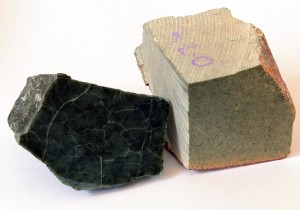Soaprock Mineral
It makes wonderful kitchen countertops. But putting aside its fabulous looks, soapstone (or soaprock) has many outstanding physical qualities. Especially those focused on coping with high heat levels. Some of the refractory properties soapstone has are even better than those found in heat resistant firebricks. How about well performing baking stones? Then stove or the once popular original fireplace linings.
A truly efficient baking oven system needs to meet well two certain thermal characteristics. The faster the heat absorption into the mass is the better (speed of heat soak from a heat source). Thermal Conductivity. That’s the first one. The second is Specific Heat. It’s about material heat storing capacity (how well and how much of heat is stored in the body mass – heat retention.) As it’s designed, soapstone fulfills both criteria and more extremely well – including a very high heat withstanding on reheating over and over again

By nature’s creation, in mass sense, this rock solid soapstone is composed of 67% of silica (Silicon dioxide – SiO2) and 33% magnesia (Magnesium oxide – MgO). Hence its wonderful thermal properties can be useful either in culinary arts practice or for room heating – ovens – stoves – pits – fireplaces. Or all such segments in one unit. It remains food-grade healthy in heated up or in cold state. Plus it will not degrade by heating nor peel down from reheating over and over again. In the other extreme of its resistance to stress from heat, soapstone copes real well also with freezing conditions. It is truly one amazing not just refractory material.
The high talc content, between 30% to 80% in its body, makes soapstone relatively soft. It definitely is not a hard rock like a granite for instance. When this soap stone gets heated reaching temperatures around 1100°C = 2012°F it hardens marginally (approximately twice as high level to what can be achieved in a semi-opened-source from wood fire heat.) But, at the same time, it does not shrink down in the heat as clay would. E.g. fireclay or pottery clays have a lots higher shrinkage ratio. Metal casting molds can be carved from this stone. It has very high degree of thermal stability. Hence another positive aspect related to business with refractories.
| Physical – Mechanical – Thermal – properties of soapstone | |
|---|---|
| Specific heat capacity | 785 J/Kg.°K |
| Thermal conductivity | 12.5 W/m.°K |
| Melting point temperature | > 2912°F = 1600°C (+) |
| Comprehensive strength | 34 MPa (Megapascals) |
| Transverse strength | 12.6 MPa (Megapascals) |
| Permanent linear change on Reheating to 1022°F = 550°C | nearly none (n/a) |
| Modulus of rupture | 13.2 MPa (Mega-pascals) |
| Apparent porosity(this is NOT a softness) | Non-porous(or perhaps 99.9% non-porous) |
| Mass density of soapstone | |
| Mass density of soapstone | grams per cubic centimeter |
| 1.709 oz/in3 (cu in) | ounces per cubic inch |
| 2,956.0 kg/m3 | kilograms per cubic meter |
| 184.54 lb/ft3 (cu ft) | pounds per cubic foot |
| 4,982.5 lb/yd3 (cu yd) | pounds per cubic yard |
| 137.05 kin/cu-shaku | Japanese kin per cubic shaku |
| 218.3 jīn/cu-chǐ | Chinese jīn per cubic chǐ |
| Naturally occurring properties variations should be expected. | |
Power by Enlink Trading Co. Pvt Ltd
Designed and Developed by Shopweb